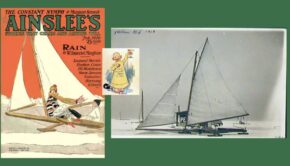Equalizing starts for different age groups
Published on June 2nd, 2023
For iceboating, everyone gets positioned on the start line to wait for the signal. All bows are even, but once the race gets underway, a good start has everything to do with pushing skills to gain an edge. It is highly athletic moment which André Baby worries is a problem with the sport. Here is his commentary in the International DN Yacht Racing Association magazine:
As we racers get on in years, nature inevitably takes its toll and our expectations, including those in the iceboat racing world, must be modified.
As in all sailing races, the start is a key component of a successful race: if you can’t run as fast as the other guys, you often end up sailing in their dirty air, and you are off to a bad start. At best, you claw your way back to the middle of the fleet, but more often than not, you end up at the tail end of it.
After a while, one’s enthusiasm and motivation decline, and lead to questioning if one should race at all.
A few years ago, during the New England Championships on Lake Winnipesaukee, I suggested to the PRO that we try a staggered start: all those racers over 70 years old, ones with running impediments, such as replaced hips, knees etc. would start at the drop of the first of two flags. Approximately 5 seconds later, the PRO would drop the second flag, and the rest of the fleet would start.
The formula worked: all of us “mature” sailors got off to a clean start, and the young “gazelles” usually caught up to us shortly thereafter, but we started sailing at roughly the same time. At the first windward mark, the faster sailors took the lead. The overall objective of keeping older sailors in the game was met, and all were pleased with the results.
At a time when we as a class are trying to keep as many sailors as active racers as possible, I believe this formula could be applied to higher levels of racing. In its effort to keep as many racers as possible, the ILCA Class has a formula for equalizing different age groups, so we should seriously consider doing the same.
The staggered start method is easy to apply, and does not impose any additional burden on the scorers who record the results in the usual fashion.








 We’ll keep your information safe.
We’ll keep your information safe.